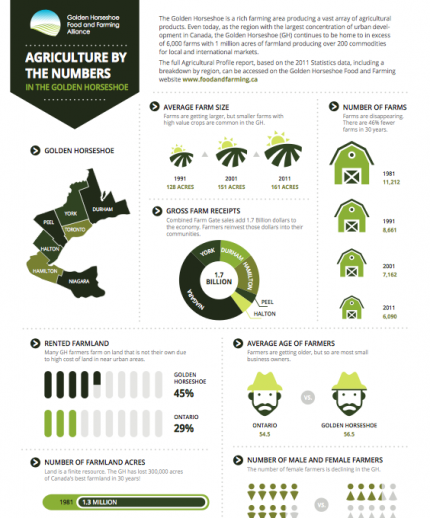Agriculture and Agri-Food Economic Profile for the Golden Horseshoe
Posted: November 19, 2014
Categories: GoodFoodBites / News from Sustain Members / Research
 The Golden Horseshoe Food and Farming Alliance (GHFFA) released an Agriculture and Agri-Food Economic Profile for the Golden Horseshoe last month, analyzing data surrounding economic impact, number of farms, farmland area and sizes, average age of farm operators and more in the regions across the Horseshoe.
The Golden Horseshoe Food and Farming Alliance (GHFFA) released an Agriculture and Agri-Food Economic Profile for the Golden Horseshoe last month, analyzing data surrounding economic impact, number of farms, farmland area and sizes, average age of farm operators and more in the regions across the Horseshoe.
More recently, the GHFFA also shared an infographic (to the left), visually summarizing some key takeaways of the report. The infographic lays out some interesting statistics in the area’s agriculture sector from the past 30 years.
“[F]armers are getting older (the average age of farmers in 2011 was 54.5 in Ontario, and 56.5 in the Golden Horseshoe), there are fewer women farming, and while farms are getting larger in size, the number of farms and acres of farmland in the Golden Horseshoe are shrinking. In 1981, there were 11,212 farms in the Golden Horseshoe, and 30 years later in 2011, that number was nearly cut in half to 6,090,” shares the Alliance’s blog post.
The report also looks at the overarching successes and challenges the area faces.
The Golden Horseshoe, the region with the largest concentration of urban development in Canada, continues to be home to more than 6,000 farms, with 1 million acres of farmland, producing over 200 commodities for local and international markets.
For a summary presentation, or to view the Agricultural Profile report in full (including a breakdown by region), visit the Golden Horseshoe Food and Farming Alliance website.
